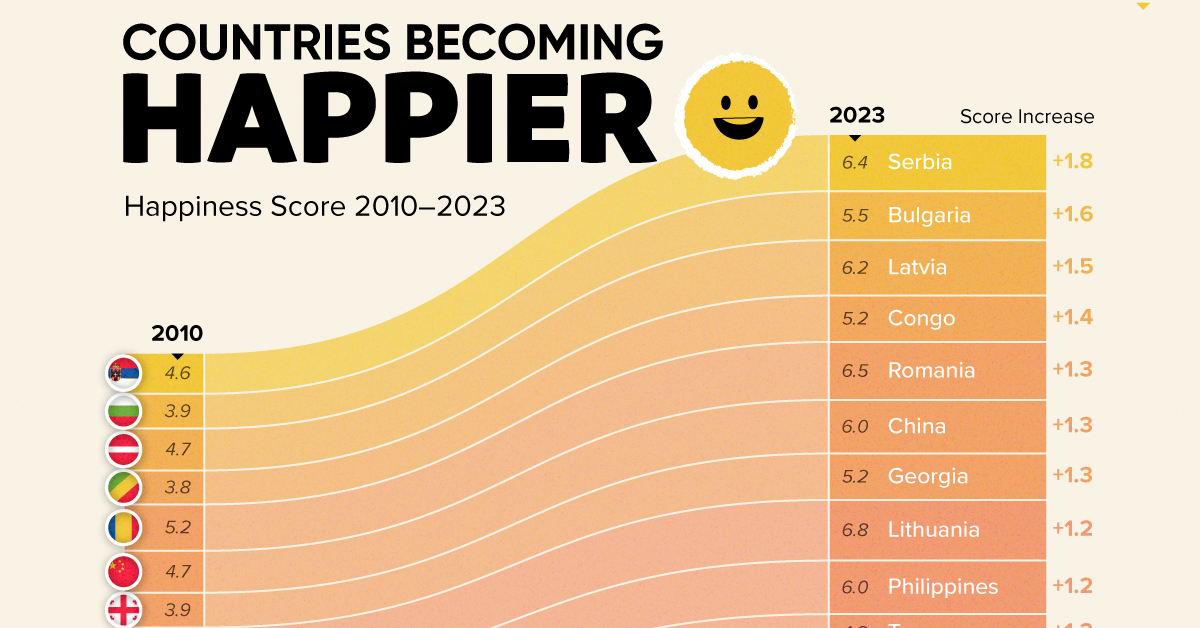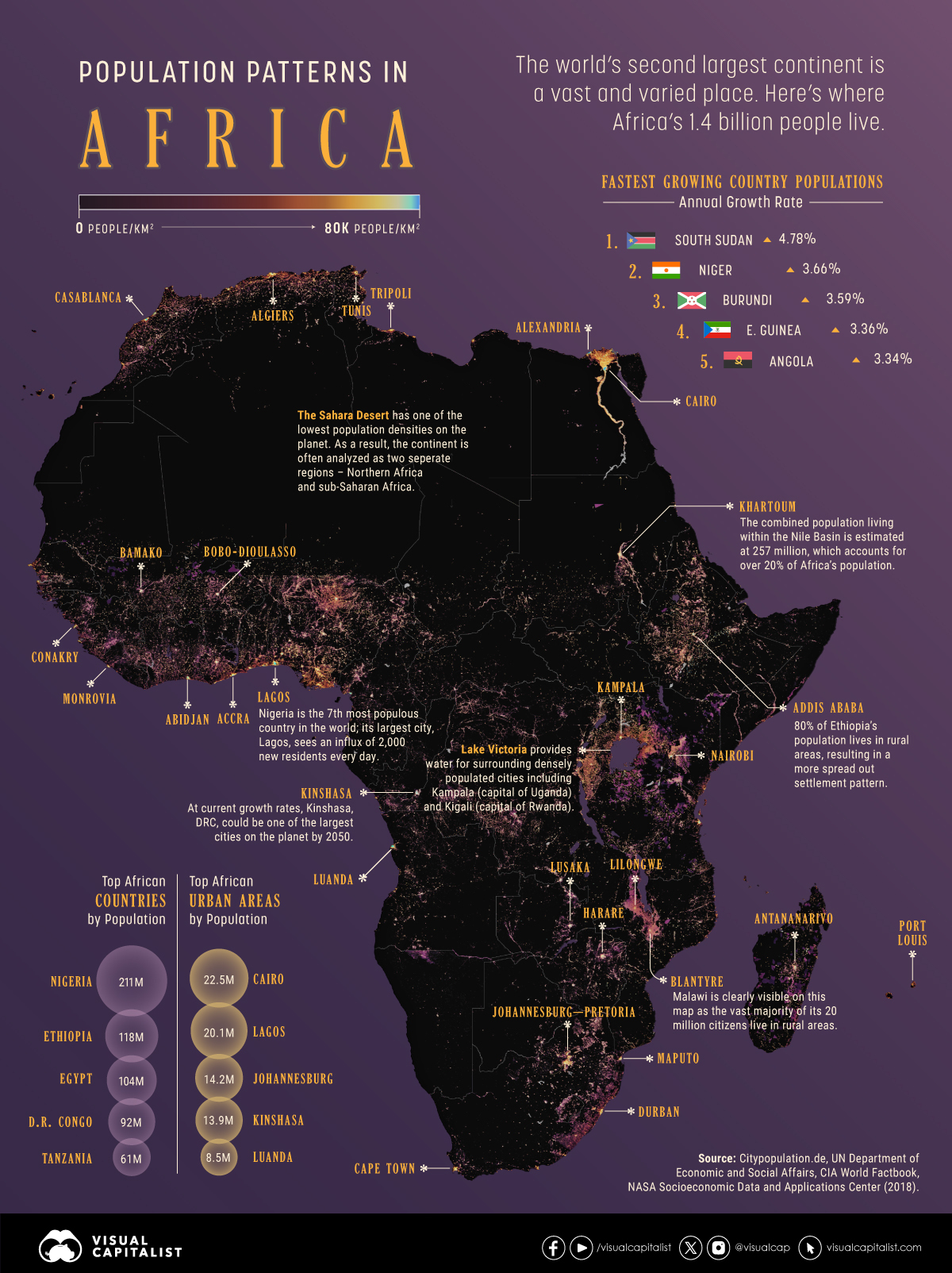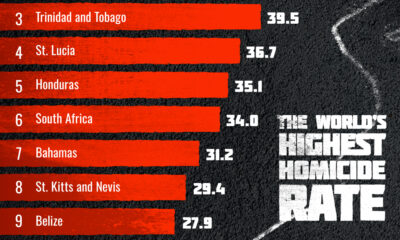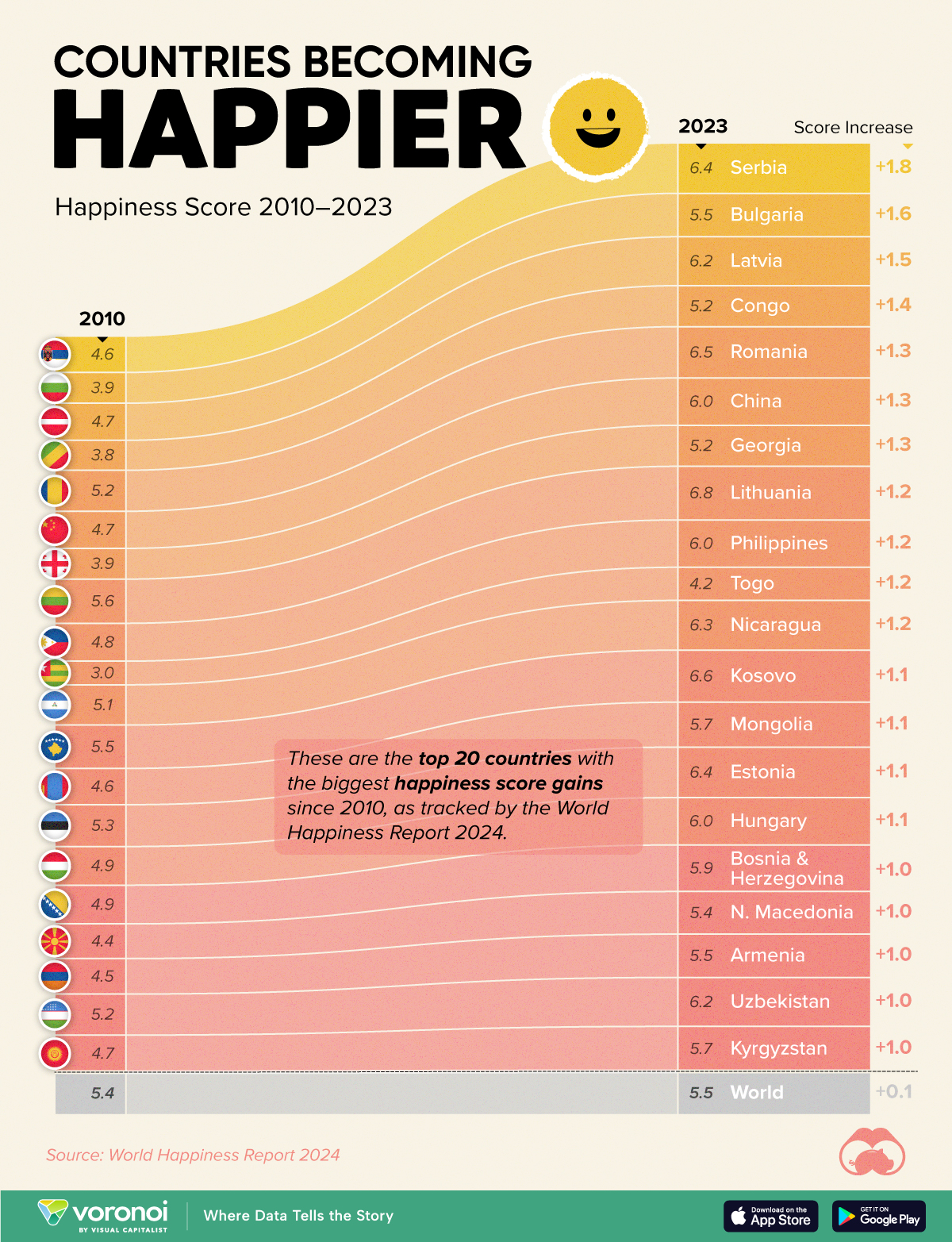Countries
Mapped: Africa’s Population Density Patterns
![]() See this visualization first on the Voronoi app.
See this visualization first on the Voronoi app.
Mapped: Africa’s Population Density Patterns
This was originally posted on our Voronoi app. Download the app for free on iOS or Android and discover incredible data-driven charts from a variety of trusted sources.
Africa, the world’s second largest continent, spans over 30 million km2, home to the not only world’s biggest desert but also the second-largest tropical rainforest, and of course, approximately 1.4 billion people.
In this infographic, we map out the continent’s population density patterns. It’s a prime example of how humans congregate near fresh water and around the edges of natural obstacles.
This population density data comes from the Gridded Population of the World dataset created by the Center for International Earth Science Information Network (CIESIN) hosted by NASA’s Socioeconomic Data and Applications Center (SEDAC).
Ranked: Most Populous African Countries
Africa’s second largest economy, Nigeria, is also its most populous: more than 220 million people live in this diverse West African country with 250 ethnic groups, speaking over 500 different languages.
And the nation is only growing. By 2100, it’s estimated that the Nigerian population could be more than three-fold its current size, at nearly 800 million residents, becoming the second-most populous country in the world.
| Rank | Country | Population |
|---|---|---|
| 1 | 🇳🇬 Nigeria | 224M |
| 2 | 🇪🇹 Ethiopia | 127M |
| 3 | 🇪🇬 Egypt | 112M |
| 4 | 🇨🇩 DRC | 102M |
| 5 | 🇹🇿 Tanzania | 67M |
| 6 | 🇿🇦 South Africa | 59M |
| 7 | 🇰🇪 Kenya | 55M |
| 8 | 🇺🇬 Uganda | 49M |
| 9 | 🇸🇩 Sudan | 48M |
| 10 | 🇩🇿 Algeria | 46M |
Source: UN Department of Economic and Social Affairs, World Population Prospects. (2022)
Across the continent, along its eastern side, Ethiopia, is the second-most populous country on the continent. Unlike Nigeria—which has nearly 20 cities with at least half a million residents—more than three-quarters of Ethiopia’s 127 million people live in rural communities.
Ranked third, Egypt (112 million) is the only North African country in the top five by population. The Democratic Republic of the Congo (DRC) comes in fourth (102 million), with Tanzania (67 million) rounding out the top five.
Ranked: Fastest Growing African Countries By Population
In the year 1900, Africa accounted for 9% of the world’s population. Currently its share stands close to 18%. By 2025, the International Monetary Fund (IMF) expects one in four people in the world to live in Africa, and says the continent’s demographic transition has the power to “transform the world.”
The most populous African countries (DRC, Tanzania, Ethiopia, Nigeria, and Egypt) will contribute the lion’s share to this growth of course, but within the continent, other countries are also seeing relatively rapid population growth.
| Rank | Country | Growth Rate |
|---|---|---|
| 1 | 🇸🇸 South Sudan | 4.78% |
| 2 | 🇳🇪 Niger | 3.66% |
| 3 | 🇧🇮 Burundi | 3.59% |
| 4 | 🇬🇶 Equatorial Guinea | 3.36% |
| 5 | 🇦🇴 Angola | 3.34% |
| 6 | 🇧🇯 Benin | 3.31% |
| 7 | 🇺🇬 Uganda | 3.22% |
| 8 | 🇨🇩 DRC | 3.13% |
| 9 | 🇹🇩 Chad | 3.05% |
| 10 | 🇲🇱 Mali | 2.93% |
Source: CIA World Factbook.
In South Sudan, the world’s newest country, the population is growing at nearly 5% every year. The broader sub-Saharan population meanwhile is growing at half that rate. Aside from a higher fertility rate, the country is also seeing an influx of refugees from conflict areas in neighboring Sudan.
While no other African nation is quite matching South Sudan’s population growth, several of Africa’s poorer economies are also posting an annual population increase of more than 3% including Niger, Burundi, and Chad.
Ranked: Most Populous African Cities
About half of Africa lives in urban areas, which is less than the global average of 57%. The 10 most populous cities on the continent together account for about 115 million people, more than 1.5x the UK’s total population.
Egypt’s capital, Cairo, built along the banks of the Nile, is home to more than 22 million residents, and ranks as Africa’s largest city. This bustling metropolis has stood as an important trade juncture between continents for more than 1,400 years—and is still somehow one of Egypt’s younger cities.
| Rank | City | Country | Population |
|---|---|---|---|
| 1 | Cairo | 🇪🇬 Egypt | 22.2M |
| 2 | Lagos | 🇳🇬 Nigeria | 21.4M |
| 3 | Kinshasa | 🇨🇩 DRC | 15.0M |
| 4 | Johannesburg | 🇿🇦 South Africa | 14.8M |
| 5 | Luanda | 🇦🇴 Angola | 9.0M |
| 6 | Khartoum | 🇸🇩 Sudan | 6.9M |
| 7 | Abidjan | 🇨🇮 Cote d'Ivoire | 6.6M |
| 8 | Nairobi | 🇰🇪 Kenya | 6.6M |
| 9 | Accra | 🇬🇭 Ghana | 6.4M |
| 10 | Dar es Salaam | 🇹🇿 Tanzania | 6.0M |
Source: Urban agglomerates (2023) Citypopulation.de.
Down south, across the Sahara desert, and near the shores of the Atlantic, Nigeria’s former capital Lagos has slightly more than 21 million people. The city’s name comes from the numerous surrounding lagoons, and its original name in Yoruba, “Eko”, also means “lake.” Population estimates for the city are often disputed because of several different administrative regions, but also because of how fast Lagos is growing: it’s estimated 2,000 new residents move in every day.
Kinshasa, the capital of the DRC ranks third with about 15 million residents, and is slated to become the fourth largest city in the world, with 35 million people, by 2050.
Johannesburg, South Africa (15 million), and Luanda, Angola (9 million) round out the top five most populous African cities.
Demographics
Countries With the Largest Happiness Gains Since 2010
Tracking Gallup survey data for more than a decade reveals insights into the regions seeing happiness gains.

Countries With the Largest Happiness Gains Since 2010
This was originally posted on our Voronoi app. Download the app for free on iOS or Android and discover incredible data-driven charts from a variety of trusted sources.
In 2011, Bhutan sponsored a UN resolution that invited governments to prioritize happiness and well-being as a way to measure social and economic development.
And thus, the World Happiness Report was born.
In 2012, the first report released, examining Gallup poll data from 2006–2010 that asked respondents in nearly every country to evaluate their life on a 0–10 scale. From this they extrapolated a single “happiness score” out of 10 to compare how happy countries are.
More than a decade later, the 2024 World Happiness Report continues the mission to quantify, measure, and compare well-being. Its latest findings also include how countries have become happier in the intervening years.
We visualize these findings in the above chart, which shows the 20 countries that have seen their happiness scores grow the most since 2010.
Which Countries Have Become Happier Since 2010?
Serbia leads a list of 12 Eastern European nations whose average happiness score has improved more than 20% in the last decade.
In the same time period, the Serbian economy has doubled to $80 billion, and its per capita GDP has nearly doubled to $9,538 in current dollar terms.
| Rank | Country | Happiness Score Gains (2010–2024) | 2024 Happiness Score (out of 10) |
|---|---|---|---|
| 1 | 🇷🇸 Serbia | +1.8 | 6.4 |
| 2 | 🇧🇬 Bulgaria | +1.6 | 5.5 |
| 3 | 🇱🇻 Latvia | +1.5 | 6.2 |
| 4 | 🇨🇬 Congo | +1.4 | 5.2 |
| 5 | 🇷🇴 Romania | +1.3 | 6.5 |
| 6 | 🇨🇳 China | +1.3 | 6.0 |
| 7 | 🇬🇪 Georgia | +1.3 | 5.2 |
| 8 | 🇱🇹 Lithuania | +1.2 | 6.8 |
| 9 | 🇵🇭 Philippines | +1.2 | 6.0 |
| 10 | 🇹🇬 Togo | +1.2 | 4.2 |
| 11 | 🇳🇮 Nicaragua | +1.2 | 6.3 |
| 12 | 🇽🇰 Kosovo | +1.1 | 6.6 |
| 13 | 🇲🇳 Mongolia | +1.1 | 5.7 |
| 14 | 🇪🇪 Estonia | +1.1 | 6.4 |
| 15 | 🇭🇺 Hungary | +1.1 | 6.0 |
| 16 | 🇧🇦 Bosnia & Herzegovina | +1.0 | 5.9 |
| 17 | 🇲🇰 North Macedonia | +1.0 | 5.4 |
| 18 | 🇦🇲 Armenia | +1.0 | 5.5 |
| 19 | 🇺🇿 Uzbekistan | +1.0 | 6.2 |
| 20 | 🇰🇬 Kyrgyzstan | +1.0 | 5.7 |
| N/A | 🌍 World | +0.1 | 5.5 |
Since the first report, Western Europe has on average been happier than Eastern Europe. But as seen with these happiness gains, Eastern Europe is now seeing their happiness levels converge closer to their Western counterparts. In fact, when looking at those under the age of 30, the most recent happiness scores are nearly the same across the continent.
All in all, 20 countries have increased their happiness score by a full point or more since 2010, on the 0–10 scale.
-

 Misc1 week ago
Misc1 week agoHow Hard Is It to Get Into an Ivy League School?
-

 Technology2 weeks ago
Technology2 weeks agoRanked: Semiconductor Companies by Industry Revenue Share
-

 Markets2 weeks ago
Markets2 weeks agoRanked: The World’s Top Flight Routes, by Revenue
-

 Countries2 weeks ago
Countries2 weeks agoPopulation Projections: The World’s 6 Largest Countries in 2075
-

 Markets2 weeks ago
Markets2 weeks agoThe Top 10 States by Real GDP Growth in 2023
-

 Demographics2 weeks ago
Demographics2 weeks agoThe Smallest Gender Wage Gaps in OECD Countries
-

 United States2 weeks ago
United States2 weeks agoWhere U.S. Inflation Hit the Hardest in March 2024
-

 Environment2 weeks ago
Environment2 weeks agoTop Countries By Forest Growth Since 2001












